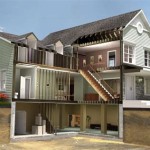How to Build a Basement Storage Shelf
Basements, often relegated to the status of unfinished spaces, offer valuable storage potential for homes. Efficiently organizing these underground areas necessitates the implementation of robust storage solutions. One effective approach involves constructing custom-built shelving units tailored to the specific needs and dimensions of the basement. This article provides a comprehensive guide on how to build a basement storage shelf, covering essential planning considerations, material selection, construction steps, and safety precautions.
Planning and Design Considerations
Prior to commencing the construction phase, meticulous planning and design are paramount. This initial stage determines the overall functionality and structural integrity of the storage shelf. The following factors warrant careful evaluation:
1. Assessing Storage Needs: The first step involves determining the types of items that the shelving unit will accommodate. Consider the dimensions, weight, and quantity of the items to be stored. This assessment informs the required shelf depth, height, and load-bearing capacity. Evaluate whether you need shelving for heavy items like tools and equipment or lighter items like seasonal decorations and books. Consider the future storage needs as well. It's often wise to overestimate your storage needs to allow for flexibility and expansion in the future.
2. Measuring the Available Space: Accurately measure the designated area in the basement where the storage shelf will be installed. Account for any obstructions, such as pipes, ductwork, or electrical panels. Consider the ceiling height and any sloping sections of the basement. The dimensions obtained during this process will dictate the maximum height, width, and depth of the shelving unit. Make sure to measure multiple times to ensure accuracy, as slight variations in basement walls are common.
3. Determining Shelf Configuration: Decide on the desired number of shelves and the vertical spacing between them. This configuration should be optimized to accommodate the various items to be stored. Adjustable shelves offer greater flexibility, allowing for future modifications as storage needs evolve. Consider the ergonomic aspects of shelf height for easy access and avoid placing heavy items on high shelves to prevent strain or injury. Consider whether you want open shelves or a closed cabinet-style shelf. If you are storing items that could be damaged by moisture, closed cabinets may be a better option.
4. Selecting Materials: The choice of materials significantly impacts the durability, cost, and aesthetic appeal of the storage shelf. Common materials include lumber (e.g., pine, fir, pressure-treated wood), plywood, and metal. Consider the moisture levels in the basement when selecting materials. Pressure-treated lumber is recommended for areas prone to dampness or flooding. Metal shelving is durable and resistant to moisture, making it a suitable option for basement environments. Evaluate the load-bearing capacity of the chosen materials to ensure they can safely support the anticipated weight. The type of fasteners (screws, nails, bolts) should also be chosen based on the materials being used and the expected load.
5. Creating a Detailed Plan: Translate the accumulated information into a detailed plan or sketch of the storage shelf. This plan should include all dimensions, the number of shelves, material specifications, and joinery methods. A well-defined plan serves as a roadmap for the construction process, minimizing errors and ensuring a cohesive final product. Consider creating a digital model using building software for a more detailed plan. This allows for easy modification and visualization of the final product.
Construction Steps
With a comprehensive plan in place, the construction phase can commence. This section outlines the step-by-step process of building a basement storage shelf:
1. Gather Tools and Materials: Assemble all necessary tools and materials before starting the construction process. This includes a measuring tape, level, saw (circular or hand saw), drill, screwdriver, sandpaper, safety glasses, and the selected building materials. Having all the necessary tools readily available streamlines the construction process and minimizes interruptions. Ensure all power tools are in good working order and that appropriate safety gear is worn at all times.
2. Cut the Lumber: Cut the lumber according to the dimensions specified in the plan. Accurate measurements and precise cuts are crucial for ensuring the structural integrity of the shelving unit. Use a saw guide to ensure straight and accurate cuts. Label each piece of lumber after cutting to avoid confusion during assembly. If desired, sand the edges of the cut lumber to prevent splinters.
3. Assemble the Frame: Construct the frame of the storage shelf using the cut lumber. This typically involves attaching the vertical supports to the horizontal top and bottom pieces. Use screws or nails to securely join the pieces together. Ensure the frame is square and level before proceeding to the next step. Use a carpenter's square to check for squareness and adjust as needed. Clamps can be used to hold the pieces together while fastening them.
4. Install the Shelves: Attach the shelves to the frame. The shelves can be attached using screws, nails, or shelf supports. For adjustable shelves, install shelf supports at the desired intervals. Ensure the shelves are level and evenly spaced. Consider using a level to ensure the shelves are aligned horizontally. If using shelf supports, make sure they are properly aligned and securely attached to the frame.
5. Reinforce the Structure: Reinforce the structure of the storage shelf by adding diagonal bracing or back panels. This will increase the stability and load-bearing capacity of the unit. Diagonal bracing can be added to the back of the shelving unit using lumber or metal straps. Back panels can be made from plywood or hardboard. Ensure these reinforcements are securely attached to the frame and shelves.
6. Finishing Touches: Once the basic structure is complete, add any desired finishing touches. This may include sanding the surfaces, applying a coat of paint or stain, and adding edge banding to the shelves. Finishing the shelving unit will improve its appearance and protect the wood from moisture and wear. Choose a paint or stain that is suitable for basement environments and resistant to moisture. Allow the finish to dry completely before placing items on the shelves.
Safety Precautions
Prioritizing safety during the construction process is essential to prevent accidents and injuries. The following safety precautions should be observed:
1. Wear Protective Gear: Always wear safety glasses to protect the eyes from debris. Use ear protection when operating power tools. Wear gloves to protect the hands from splinters and sharp edges. A dust mask should be worn when sanding or cutting wood to avoid inhaling dust particles.
2. Use Power Tools Safely: Familiarize yourself with the operating instructions for all power tools before use. Ensure the tools are in good working order and that all safety guards are in place. Use the correct tool for the job and avoid forcing tools beyond their capacity. Disconnect power tools from the power source when not in use or when changing blades or bits.
3. Work in a Well-Ventilated Area: When working with paints, stains, or adhesives, ensure the area is well-ventilated to avoid inhaling harmful fumes. Use a respirator if necessary. Proper ventilation will also help to prevent the buildup of flammable fumes.
4. Lift Heavy Objects Safely: Use proper lifting techniques when moving heavy objects. Bend the knees and keep the back straight. Avoid twisting or jerking motions. Ask for assistance when lifting objects that are too heavy to handle alone.
5. Secure the Shelving Unit: Once the storage shelf is complete, securely anchor it to the wall to prevent it from tipping over. Use wall anchors that are appropriate for the wall material. This will prevent the shelving unit from falling and causing injury or damage. Consider the weight distribution when loading the shelves to further minimize the risk of tipping.
By adhering to these planning considerations, construction steps, and safety precautions, it is possible to build a functional and durable basement storage shelf that effectively optimizes storage space and enhances the overall organization of the basement.

Diy Basement Shelving The Wood Grain Cottage

How To Make A Basement Storage Shelf

How To Build Inexpensive Basement Storage Shelves

Diy Basement Shelving The Wood Grain Cottage

Diy Basement Shelves With Video Remodelando La Casa

How To Make A Basement Storage Shelf

How To Build Inexpensive Basement Storage Shelves Diy Wood

Diy Basement Shelves In A Day Merrypad

Diy Basement Shelves With Video Remodelando La Casa

Basement Storage Shelves And Design Ideas Full Of Potential







